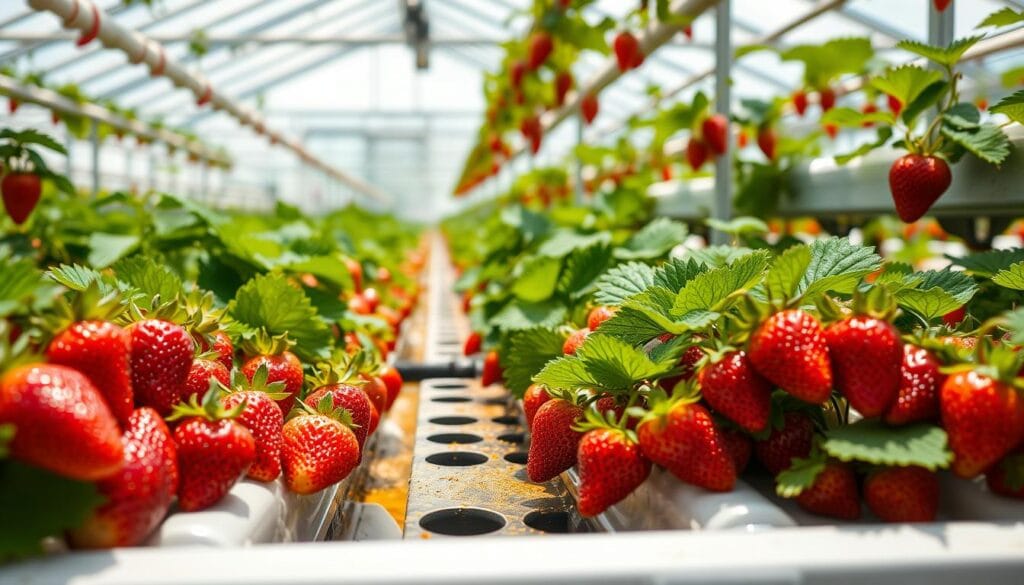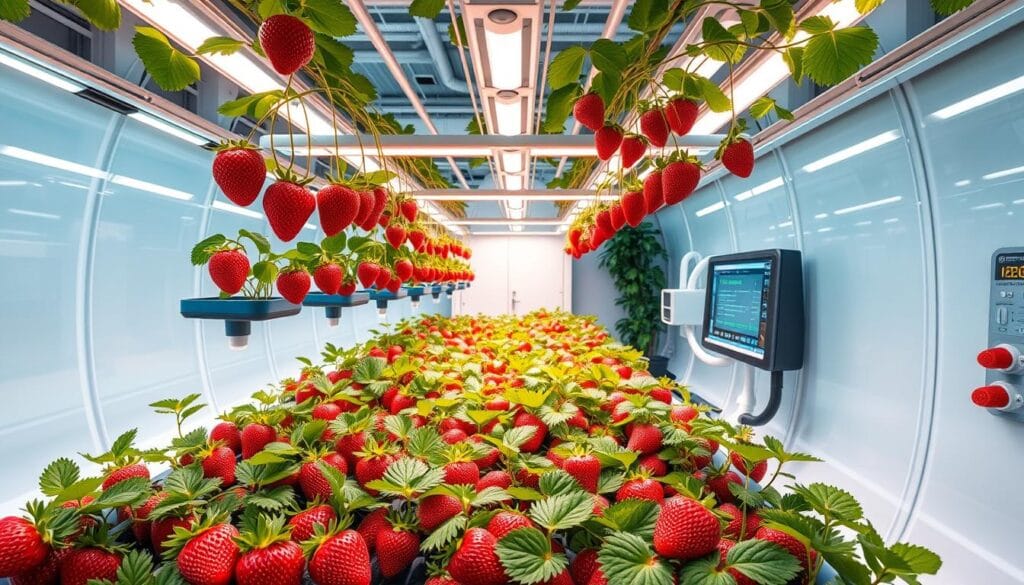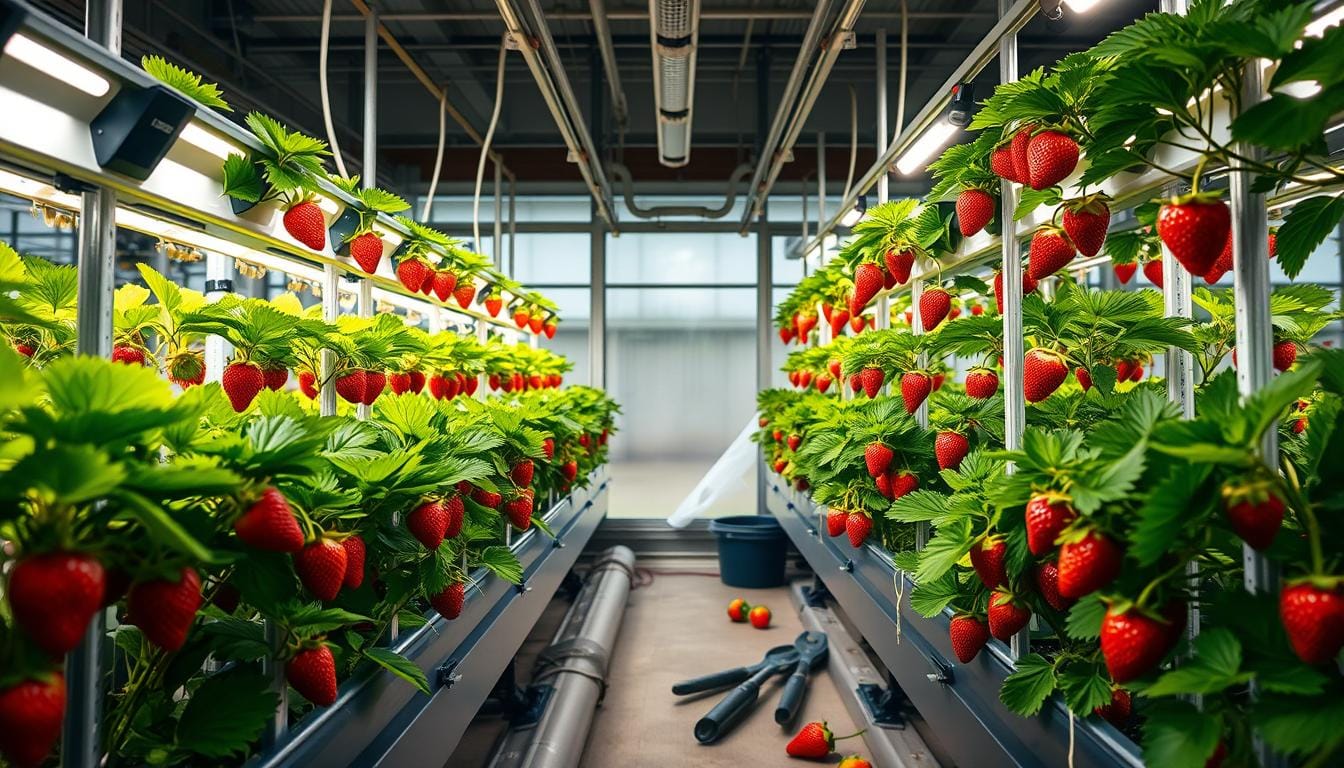Ever dreamed of picking fresh strawberries from your living room? Hydroponic strawberries are changing how we grow berries. They turn urban spaces into personal gardens.
Imagine growing strawberries without soil. That’s the magic of hydroponics. It’s not just a trend; it’s a new way to grow berries.
Hydroponic strawberries offer big advantages. They save space and ensure quality. These systems are changing how we get fresh food.
Whether you love gardening or just want to learn, hydroponic strawberries are fascinating. They show how technology is changing our food world.
Key Takeaways
- Hydroponic strawberries grow faster than traditional soil-based methods
- Year-round strawberry production is possible with indoor systems
- Water usage is significantly reduced in hydroponic cultivation
- Precise nutrient control leads to higher-quality fruit
- Space-efficient growing techniques maximize crop yields
Understanding the Science Behind Hydroponic Strawberries
Hydroponic strawberry farming is a new way to grow fruit. It uses no soil and changes how we farm. This method provides nutrients directly to the roots through the water, ensuring efficient absorption and promoting faster healthier growth.
Basic Principles of Soilless Growth
Strawberry plants can grow well without soil thanks to controlled environment agriculture. This method gives nutrients directly to the roots through water. The benefits are:
- Precise nutrient management
- Reduced water consumption
- Enhanced crop control
- Year-round production capabilities
Nutrient Delivery Systems
The nutrient film technique (NFT) is a top choice for growing hydroponic strawberries. It moves a thin layer of nutrient-rich water over the roots. This ensures the plants get what they need and waste is kept low.
“In hydroponic systems, plants receive exactly what they need, when they need it.” – Agricultural Innovation Research.
Water and pH Balance Requirements
Keeping the right pH balance is key for growing hydroponic strawberries. The best pH range is 5.5 to 6.4. This helps plants absorb nutrients well and stay healthy. Special agents like potassium bicarbonate help keep the solution stable.
| pH Level | Plant Impact |
|---|---|
| Below 4.0 | Nutrient lockout |
| 5.5 – 6.4 | Optimal growth |
| Above 7.0 | Reduced nutrient uptake |
Learning these scientific basics can change strawberry farming with new hydroponic methods.
Why Hydroponic Strawberries Grow Faster Than Traditional Methods
Hydroponic strawberries are changing how we grow fruit. They grow much faster than old methods. This is because they use special systems that make plants grow quickly.
“Speed is the new currency of business, and in agriculture, hydroponic strawberries are leading the revolution.” – Agricultural Innovation Quarterly
So, why do hydroponic strawberries grow so fast? It’s because of a few important things:
- Direct nutrient access eliminates absorption barriers
- A controlled environment minimizes plant stress
- Precise oxygen and nutrient delivery
- Elimination of soil-borne diseases
Hydroponic strawberries can grow up to 5 times faster than plants in soil. This is because they get everything they need in a perfect environment. This environment helps them grow fast.
| Growth Factor | Hydroponic System | Traditional Soil Method |
|---|---|---|
| Water Usage | 90% Less Water | Standard Agricultural Consumption |
| Growth Rate | 5x Faster | Standard Growth Cycle |
| Nutrient Efficiency | Direct Root Delivery | Indirect Soil Absorption |
LED grow lights and special nutrients are key for hydroponic strawberries. They keep the plants in the best conditions. This means they grow fast.
Using hydroponics means you get your crops faster and more often. It also means you can predict when you’ll have fruit. Try this new way of growing strawberries to change your farming.
The Environmental Benefits of Growing Strawberries Hydroponically
Vertical farming has changed how we grow food, like greenhouse strawberries. This new way of farming is better for the environment than old methods.
Hydroponic strawberry farming is a big step towards sustainable agriculture. It has many environmental benefits that traditional farming can’t match.
Dramatically Reduced Water Consumption
Hydroponic systems save a lot of water. They use up to 90% less water compared to conventional farming methods, making them highly water-efficient. This is because they have a closed-loop system that:
- Manages water precisely
- Recycles water completely
- Wastes very little water
Minimal Pesticide Usage
Greenhouse strawberries grown hydroponically need almost no pesticides. The controlled environment keeps pests away, leading to:
- Cleaner fruit
- Less chemical exposure
- A healthier crop ecosystem
Year-Round Growing Capability
Vertical farming lets you grow strawberries all year round. This is beneficial for the environment because it:
- Reduces emissions from transportation
- Supports local food production
- Lessens the carbon footprint
“Hydroponic strawberry production represents the future of sustainable, environmentally conscious agriculture.” – Agricultural Innovation Research Institute.
Using these new farming methods helps make food production more sustainable and friendly to the environment.
Optimal Growing Conditions for Maximum Yield
Creating the perfect environment is key for top strawberry yields in hydroponics. Your strategy in controlled environment agriculture is what makes your strawberry production a success.
Temperature is very important for strawberry growth. The best range is 60-80°F. This helps plants grow strong and produce more fruit. Keeping temperatures steady prevents stress and boosts yields.
Key Optimal Conditions
- Light exposure: 14-16 hours daily using LED grow lights
- Humidity: 65-75% relative humidity
- pH levels: Maintain between 5.5-6.5
- Spacing: 8-12 inches between plants
CO2 enrichment can boost your strawberry yields by an impressive 20-30%. Using trellises and vertical growing saves space and improves fruit quality.
“Precision in environmental control transforms hydroponic strawberry cultivation from good to extraordinary.” – Agricultural Research Institute.
For successful hydroponic strawberry production, you need to keep an eye on things and make smart changes. By following these optimal growing conditions, you can create a top-notch growing space. This will give you amazing results.
Nutrient Requirements for Healthy Hydroponic Strawberry Plants
Growing hydroponic strawberries needs careful plant nutrition. You must know the right nutrient balance for strong growth and lots of fruit.
Nutrient solutions are vital for growing hydroponic strawberries. These special liquids give plants the nutrients they need directly, without soil.
Essential Macronutrients
Your hydroponic strawberries need a mix of important macronutrients:
- Nitrogen: Helps with leaf growth and plant development
- Phosphorus: Strengthens roots and helps with flowers
- Potassium: Improves fruit quality and plant health
Micronutrient Balance
Micronutrients are key for plant health. Elements like iron, manganese, and zinc keep strawberries healthy and productive.
“Balanced nutrition is the secret to thriving hydroponic strawberries.” – Hydroponic Expert.
Feeding Schedules
Adjust your nutrient solution as plants grow. Use more nitrogen when they’re young. Switch to more potassium when they start producing fruit.
| Growth Stage | Key Nutrients | EC Level |
|---|---|---|
| Vegetative | High Nitrogen | 1.0-1.2 mS/cm |
| Flowering | Balanced NPK | 1.2-1.4 mS/cm |
| Fruiting | High Potassium | 1.4-1.6 mS/cm |
Getting nutrient management right can make your hydroponic strawberry system amazing.
Common Challenges in Hydroponic Strawberry Production

Growing strawberries in hydroponic systems comes with its own set of challenges. These systems offer many benefits, but farmers must tackle specific issues to grow a successful crop.
Pest management is a key part of growing strawberries in hydroponic systems. Even with these systems, farmers face unique plant diseases and pests.
- Nutrient imbalances can quickly impact plant health
- Algae growth threatens root systems
- Root diseases like Pythium can devastate entire crops
- Temperature and humidity fluctuations create stress
“Prevention is always more effective than treatment when it comes to hydroponic systems.”
Using integrated pest management (IPM) strategies is vital for healthy strawberry crops. Keeping an eye on the environment and practicing good sanitation can greatly lower risks.
| Challenge | Prevention Strategy | Impact |
|---|---|---|
| Root Diseases | Regular system cleaning | Reduces crop loss by 50% |
| Nutrient Imbalance | Precise nutrient solution management | Improves plant vigor |
| Temperature Stress | Consistent climate control | Maintains optimal growth conditions |
Your success in hydroponic strawberry production depends on understanding and mitigating these challenges. By monitoring closely, keeping systems clean, and using targeted pest management, you can ensure your crops thrive.
Space-Saving Vertical Growing Techniques
Urban agriculture is changing how we grow food. Vertical farming is a big leap forward for indoor farming. Hydroponic strawberries are a perfect fit for these new systems. They let you grow lots of fruit in a small space.
Vertical growing has amazing benefits for strawberries. With smart designs, you can grow more in less space.
Stackable Systems Design
Modern vertical farming offers many ways to grow strawberries compactly:
- Nutrient Film Technique (NFT) vertical channels
- Tower garden systems with multiple growing levels
- A-frame hydroponic configurations
- Modular stackable containers
Light Distribution Methods
Light is key for growing strawberries vertically. LED grow lights to spread light evenly. This helps plants grow well, even in small spaces.
“Vertical farming transforms urban spaces into productive agricultural ecosystems” – AgTech Innovation Report.
Day-neutral strawberry varieties like Seascape and Albion do great in these setups. They offer consistent quality and high yields.
| Vertical System Type | Space Efficiency | Yield Potential |
|---|---|---|
| NFT Channels | High | 10x traditional farming |
| Tower Systems | Very High | 8-12x traditional farming |
Using these new vertical farming methods, you can turn any indoor area into a strawberry garden.
Comparing Soil vs. Hydroponic Strawberry Flavors
Hydroponic strawberries are giving traditional growing methods a run for their money. The precision in growing them without soil lets farmers create berries that are just as good, if not better, than those grown in soil.
Experts have found some big differences between strawberries grown in soil and those grown hydroponically:
- Nutrient control leads to sweeter berries
- Controlled environments help plants grow better
- Getting the right mix of minerals makes berries taste better
“The future of strawberry cultivation lies in understanding how environmental factors directly impact fruit taste.” – Agricultural Research Institute.
Hydroponic strawberries have some special perks when it comes to taste. Growers can tweak the nutrients to boost the berries’ health and taste.
| Flavor Characteristic | Soil-Grown Strawberries | Hydroponic Strawberries |
|---|---|---|
| Sweetness Consistency | Variable | More Uniform |
| Antioxidant Levels | Standard | Potentially Higher |
| Flavor Intensity | Dependent on Soil Quality | Precisely Controlled |
Blind taste tests show that top-notch hydroponic strawberries are almost as good as those from the soil. It all comes down to using the best-growing methods.
Advanced Technology in Modern Hydroponic Systems

Smart agriculture is changing strawberry farming with new hydroponics systems. Today, farmers use advanced tech to grow strawberries in a more precise way. This tech turns old farming methods into smart, data-based ones.
Automated farming has made growing strawberries better. IoT sensors watch important growing factors like pH levels and temperature. They do this in real time, helping farmers keep their plants healthy.
- pH levels
- Electrical conductivity
- Nutrient concentration
- Temperature and humidity
Artificial intelligence helps make hydroponic systems better. It uses algorithms to control the climate. This makes sure strawberries grow in the best conditions.
“Technology transforms agriculture from guesswork to precision engineering” – Agricultural Innovation Research Center
Robotic tech is changing strawberry farming in hydroponics. These systems can:
- Harvest strawberries with precision
- Check on plant health
- Spot diseases early
- Manage nutrients well
These advanced systems give farmers more control over growing strawberries. They save on labor and make sure strawberries grow well every time.
| Technology | Function | Efficiency Improvement |
|---|---|---|
| IoT Sensors | Real-time monitoring | Up to 35% increased precision |
| AI Climate Control | Environmental optimization | 20-25% improved growth rates |
| Robotic Harvesting | Automated plant management | 40% reduction in labor costs |
By using these advanced hydroponics systems, farmers can grow strawberries more efficiently and sustainably.
Economic Advantages of Commercial Hydroponic Strawberries
Hydroponic strawberries are changing the game in farming economics. By investing in commercial production, you can see big financial gains in modern farming.
The market for hydroponic strawberries is growing fast. It offers great chances for farmers and investors who think ahead.
Market Demand Analysis
Commercial hydroponic strawberry farming is taking off. The main reasons for this growth are:
- Year-round production capabilities
- Consistent high-quality berry supply
- Increasing consumer demand for locally grown produce
- Premium pricing for off-season strawberries
Production Cost Breakdown
It’s key to know the financial side of growing hydroponic strawberries. The start-up costs might look high, but the long-term gains are worth it.
| Cost Category | Estimated Percentage |
|---|---|
| Infrastructure Setup | 40-45% |
| Ongoing Nutrient Expenses | 15-20% |
| Energy Costs | 20-25% |
| Labor | 10-15% |
Hydroponic strawberry systems can produce up to 30% more than traditional farming. This means you can start making money back sooner because of the higher yields and better prices.
“Innovative agricultural technologies like hydroponics are transforming how we think about food production and profitability.” – Agricultural Innovation Expert.
By focusing on commercial hydroponic strawberry farming, you can gain big economic benefits in today’s farming world.
Best Strawberry Varieties for Hydroponic Growing
Choosing the right strawberry variety is key to success in hydroponic farming. Many varieties excel in soilless environments, making indoor farming a breeze.
Top strawberry varieties for hydroponics include:
- Albion: Known for consistent fruiting and disease resistance
- San Andreas: Excellent yield in indoor farming systems
- Seascape: Produces fruit continuously, growing up to 18 inches
- Chandler: Prized for its exceptional flavor
- Sweet Charlie: High productivity and sweet taste
“The right variety can transform your hydroponic strawberry production from good to extraordinary.” – Agricultural Innovation Research Center.
Everbearing varieties are perfect for hydroponics. They offer continuous harvests, unlike traditional soil-based farming.
When picking your strawberry varieties, think about growth height, fruit rate, and flavor. New varieties are being developed for hydroponics.
Key Selection Criteria
- Disease resistance
- Continuous fruiting capability
- Compact growth habits
- Flavor quality
- Adaptability to indoor farming conditions
By choosing the best strawberry varieties, you can boost your hydroponic growth. Enjoy fresh, delicious berries all year.
Conclusion
Hydroponic strawberries are a new way to grow food that’s good for the planet. This method uses up to 90% less water than old farming ways. It’s a green choice for growing strawberries.
The future of farming is bright with hydroponic systems. They use space well and give plants exactly what they need. This means you can grow more strawberries that are better in quality.
Day-neutral varieties like Albion and Seascape do great in these systems. They keep producing strawberries all year round. This is a big step forward in solving food problems worldwide.
As tech in farming gets better, hydroponic strawberries will play a key role. They let us grow fresh, safe strawberries indoors. This is great for cities and places where farming is hard.
With new tech coming, growing hydroponic strawberries will become more important. It will help make food systems around the world more sustainable.

